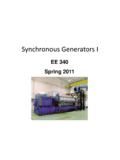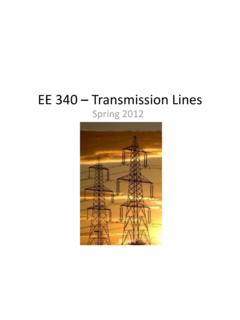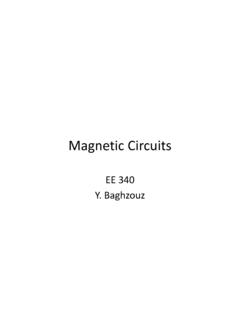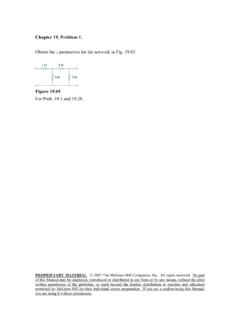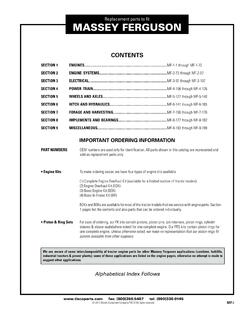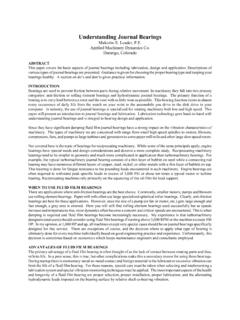Transcription of 3-Phase Induction Motors - UNLV
1 Induction Motors EE 340 Where does the power generated go? The electric energy generated purchased by consumers for different needs. This energy is converted to different forms: Lighting (indoor/outdoor CFL, incandescent, LED, ) Heating (electric water heaters, clothes dryers, electric stoves and ovens) power supply of electronic devices (computers, TV, DVD, battery chargers, home automation, ) Industrial (arc furnaces, welders, manufacturing ) Conversion to mechanical power by Motors (pumps, fans, HVAC, refrigeration compressors, power tools, food processors, escalators, elevators.)
2 Types of Electric Motors 3-Phase Induction machine construction 3 stator windings (uniformly distributed as in a synchronous generator) Two types of rotor: Squirrel cage Wound rotor (with slip rings) The rotating magnetic field The basic idea of an electric motor is to generate two magnetic fields: rotor magnetic field and stator magnetic field. The rotor will constantly be turning to align its magnetic field with the stator field. The 3-Phase set of currents, each of equal magnitude and with a phase difference of 120o, flow in the stator windings and generate a rotating field will constant magnitude.
3 The rotating magnetic field Consider a simple 3-Phase stator containing three coils, each 120o apart. Such a winding will produce only one north and one south magnetic pole; therefore, this motor would be called a two pole motor. Assume that the currents in three coils are: The magnetic flux density in the stator at any arbitrary moment is given by The rotating magnetic field The net magnetic field has a constant magnitude and rotates counterclockwise at the angular velocity . The stator rotating magnetic field can be represented as a north pole and a south pole.
4 For a two pole machine, For a p-pole machine, )(601)()(rpmnrpsfHzfsme )(120)(2)(rpmnprpsfpHzfsme Principle of operation This rotating magnetic field cuts the rotor windings and produces an induced voltage in the rotor windings Due to the fact that the rotor windings are short circuited, for both squirrel cage and wound-rotor, and induced current flows in the rotor windings The rotor current produces another magnetic field A torque is produced as a result of the interaction of those two magnetic fields Where ind is the induced torque and BR and BS are the magnetic flux densities of the rotor and the stator respectively indRskBB Induction motor speed At what speed will the Induction motor run?
5 Can the Induction motor run at the synchronous speed, why? If rotor runs at the synchronous speed, then it will appear stationary to the rotating magnetic field and the rotating magnetic field will not cut the rotor. So, no induced current will flow in the rotor and no rotor magnetic flux will be produced so no torque is generated and the rotor speed will fall below the synchronous speed. When the speed falls, the rotating magnetic field will cut the rotor windings and a torque is produced. Induction motor speed So, the Induction motor will always run at a speed lower than the synchronous speed The difference between the motor speed and the synchronous speed is called the slip speed Where nslip= slip speed nsync= speed of the magnetic field nm = mechanical shaft speed of the motor slipsyncmnnn The Slip syncmsyncnnsn Where s is the slip Notice that.
6 If the rotor runs at synchronous speed s = 0 if the rotor is stationary s = 1 Slip may be expressed as a percentage by multiplying the above by 100. Notice that the slip is a ratio and doesn t have units. Induction Motors and Transformers Both Induction motor and transformer works on the principle of induced voltage Transformer: voltage applied to the primary windings produce an induced voltage in the secondary windings Induction motor.
7 Voltage applied to the stator windings produce an induced voltage in the rotor windings The difference is that, in the case of the Induction motor, the secondary windings can move Due to the rotation of the rotor, the induced voltage in it does not have the same frequency of the stator voltage. Rotor Frequency The frequency of the voltage induced in the rotor is given by Where fr = the rotor frequency (Hz) p = number of stator poles nslip = slip speed (rpm) esynmsynrsfnspnnpf )(Rotor Frequency What would be the frequency of the rotor s induced voltage at any speed nm?
8 When the rotor is blocked (s=1) , the frequency of the induced voltage is equal to the supply frequency. On the other hand, if the rotor runs at synchronous speed (s = 0), the frequency will be zero. refs f Torque While the input to the Induction motor is electrical power, its output is mechanical power and for that we should know some terms and quantities related to mechanical power. Any mechanical load applied to the motor shaft will introduce a torque on the motor shaft. This torque is related to the motor output power and the rotor speed and.
9 OutloadmPNm 2/60mmnrad s Horse power Another unit used to measure mechanical power is the horse power. It is used to refer to the mechanical output power of the motor. Since we, as an electrical engineers, deal with watts as a unit to measure electrical power, there is a relation between horse power and watts: 746hpwatts Example A 208 V, 10 hp, four pole, 60 Hz, Y-connected Induction motor has a full-load slip of 5 percent is the synchronous speed of this motor? is the rotor speed of this motor at rated load?
10 Is the rotor frequency of this motor at rated load? is the shaft torque of this motor at rated load? Solution 1. 2. 3. 4. 120120(60)18004esyncfnrpmP (1)(1 ) 1800 1710msns nrpm 60 3refsfHz 26010746 2(1/ 60)outoutloadmmPPnhpwatt hpNm Equivalent Circuit The Induction motor is similar to the transformer with the exception that its secondary windings are free to rotate It is easier if we can combine these two circuits in one circuit but there are some difficulties.
